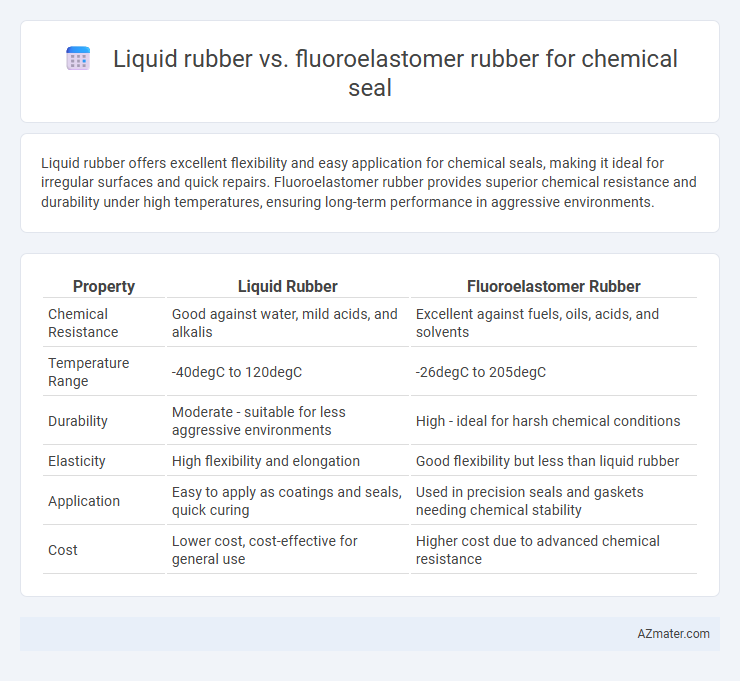Liquid rubber offers excellent flexibility and easy application for chemical seals, making it ideal for irregular surfaces and quick repairs. Fluoroelastomer rubber provides superior chemical resistance and durability under high temperatures, ensuring long-term performance in aggressive environments.
Table of Comparison
| Property | Liquid Rubber | Fluoroelastomer Rubber |
|---|---|---|
| Chemical Resistance | Good against water, mild acids, and alkalis | Excellent against fuels, oils, acids, and solvents |
| Temperature Range | -40degC to 120degC | -26degC to 205degC |
| Durability | Moderate - suitable for less aggressive environments | High - ideal for harsh chemical conditions |
| Elasticity | High flexibility and elongation | Good flexibility but less than liquid rubber |
| Application | Easy to apply as coatings and seals, quick curing | Used in precision seals and gaskets needing chemical stability |
| Cost | Lower cost, cost-effective for general use | Higher cost due to advanced chemical resistance |
Introduction to Chemical Seal Materials
Liquid rubber offers excellent flexibility and chemical resistance, making it ideal for sealing applications exposed to a broad range of solvents and corrosive substances. Fluoroelastomer rubber is renowned for its superior resistance to high temperatures and aggressive chemicals, such as fuels, acids, and oils, providing durable sealing solutions in demanding industrial environments. Selecting the appropriate material depends on the specific chemical exposure, temperature range, and mechanical stress expected in the sealing application.
Overview of Liquid Rubber
Liquid rubber is a versatile, synthetic elastomer known for its excellent chemical resistance, flexibility, and ease of application in sealing solutions. It provides seamless, durable seals that can withstand exposure to acids, solvents, and other aggressive chemicals, making it ideal for chemical seal applications. Compared to fluoroelastomer rubber, liquid rubber offers more straightforward installation and reapplication while maintaining strong adhesion and environmental resistance.
Overview of Fluoroelastomer Rubber
Fluoroelastomer rubber, known for exceptional chemical resistance and high-temperature stability, excels in demanding sealing applications exposed to aggressive chemicals and fuels. Its molecular structure provides superior resistance to oils, solvents, and acids, maintaining integrity in temperatures up to 200degC or higher. Compared to liquid rubber, fluoroelastomer seals offer enhanced durability, lower permeability, and longer service life in harsh chemical environments.
Chemical Resistance Comparison
Liquid rubber and fluoroelastomer rubber exhibit distinct chemical resistance profiles crucial for chemical seal applications. Fluoroelastomers provide superior resistance to a wide range of aggressive chemicals, including hydrocarbons, acids, and solvents, making them ideal for harsh environments. Liquid rubber, while flexible and versatile, generally offers lower resistance to strong chemicals and may degrade faster under exposure to aggressive substances.
Temperature Stability and Performance
Fluoroelastomer rubber offers superior temperature stability, maintaining performance in extreme ranges from -26degC to 204degC, making it ideal for high-heat chemical seals. Liquid rubber, while flexible and easy to apply, generally exhibits lower thermal resistance, typically stable up to around 120degC, which limits its use in high-temperature chemical environments. Fluoroelastomers exhibit enhanced chemical resistance and durability under thermal stress, ensuring longer service life in aggressive chemical sealing applications compared to liquid rubber.
Durability and Longevity
Fluoroelastomer rubber offers superior chemical resistance and high thermal stability, making it ideal for seals exposed to aggressive chemicals and extreme temperatures, ensuring exceptional durability and prolonged service life. Liquid rubber provides flexibility and ease of application but typically lacks the robust chemical resistance and long-term durability of fluoroelastomers, limiting its effectiveness in harsh chemical environments. For chemical seals requiring maximum longevity and resilience against degradation, fluoroelastomer remains the preferred choice.
Installation and Application Methods
Liquid rubber offers easy application through brush, spray, or dip methods, enabling seamless coverage and rapid curing ideal for irregular or complex chemical seals. Fluoroelastomer rubber requires curing in molds or as pre-formed sheets, demanding precise fitting and often mechanical fastening or adhesive bonding to ensure chemical resistance. Installation of liquid rubber is more adaptable for onsite repairs and retrofitting, while fluoroelastomer rubber suits high-performance seals needing controlled factory processing for optimal durability.
Cost-Effectiveness Analysis
Liquid rubber offers a lower initial cost and faster application for chemical seals, making it cost-effective for short-term or less aggressive environments. Fluoroelastomer rubber, while more expensive upfront, provides superior chemical resistance and durability, reducing maintenance and replacement expenses over time. For industries handling highly aggressive chemicals, fluoroelastomer's extended lifespan often results in lower total cost of ownership compared to liquid rubber alternatives.
Industry Use Cases and Recommendations
Liquid rubber offers exceptional chemical resistance and flexibility, making it ideal for industrial sealing applications involving acids, solvents, and corrosive fluids in chemical processing plants and wastewater treatment facilities. Fluoroelastomer rubber provides superior thermal stability and resistance to aggressive fuels, oils, and high-temperature chemicals, commonly used in automotive, aerospace, and oil and gas industries. For sealing applications requiring extended durability under extreme thermal and chemical exposure, fluoroelastomers are recommended, while liquid rubber suits environments demanding flexible, cost-effective sealing with broad chemical compatibility.
Conclusion: Selecting the Right Rubber for Chemical Seals
Liquid rubber offers excellent flexibility and ease of application for chemical seals, making it ideal for custom shapes and complex surfaces. Fluoroelastomer rubber provides superior chemical resistance, high temperature tolerance, and long-term durability, making it the preferred choice for aggressive chemical environments. Selecting the right rubber depends on the specific chemical exposure, temperature range, and sealing requirements, with fluoroelastomers favored for harsh conditions and liquid rubber suited for adaptable, less demanding applications.

Infographic: Liquid rubber vs Fluoroelastomer rubber for Chemical seal
 azmater.com
azmater.com